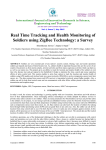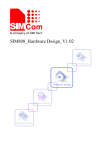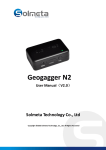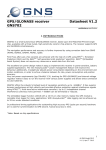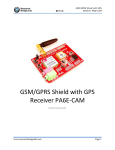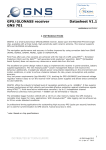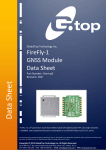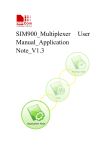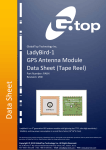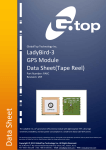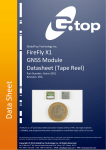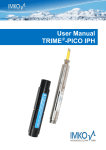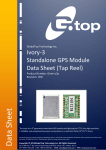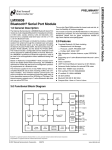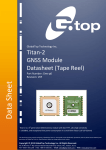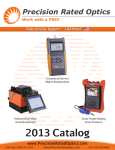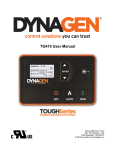Download SIM39EA_Hardware Design_V1.00
Transcript
SIM39EA_Hardware Design_V1.00 Smart Machine Smart Decision Document Title SIM39EA Hardware Design Version 1.00 Date 2013-08-01 Status Release Document Control ID SIM39EA_Hardware Design_V1.00 General Notes SIMCom offers this information as a service to its customers, to support application and engineering efforts that use the products designed by SIMCom. The information provided is based upon requirements specifically provided to SIMCom by the customers. SIMCom has not undertaken any independent search for additional relevant information, including any information that may be in the customer’s possession. Furthermore, system validation of this product designed by SIMCom within a larger electronic system remains the responsibility of the customer or the customer’s system integrator. All specifications supplied herein are subject to change. Copyright This document contains proprietary technical information which is the property of SIMCom Limited, copying of this document and giving it to others and the using or communication of the contents thereof, are forbidden without express authority. Offenders are liable to the payment of damages. All rights reserved in the event of grant of a patent or the registration of a utility model or design. All specification supplied herein are subject to change without notice at any time. Copyright © Shanghai SIMCom Wireless Solutions Ltd. 2013 SIM39EA_Hardware Design_V1.00 2 2013-08-01 Smart Machine Smart Decision Contents Contents.................................................................................................................................................................... 3 Version History ........................................................................................................................................................ 7 1 Introduction....................................................................................................................................................... 8 2 SIM39EA Overview.......................................................................................................................................... 8 2.1 SIM39EA Functional Diagram................................................................................................................. 8 2.2 GPS Performance ..................................................................................................................................... 9 2.3 General features...................................................................................................................................... 10 3 Package Information .......................................................................................................................................11 3.1 Pin out Diagram.......................................................................................................................................11 3.2 Pin Description ........................................................................................................................................11 3.3 Package Dimensions............................................................................................................................... 12 3.4 SIM39EA Recommended PCB Decal .................................................................................................... 13 4 Application Interface...................................................................................................................................... 14 4.1 Power Management ................................................................................................................................ 14 4.1.1 Power Input ......................................................................................................................................... 14 4.1.2 Starting SIM39EA............................................................................................................................... 14 4.1.3 Verification of SIM39EA Start............................................................................................................ 14 4.1.4 Power Saving Modes........................................................................................................................... 14 4.1.5 Operating Mode .................................................................................................................................. 15 4.1.5.1 Full on Mode........................................................................................................................................ 15 4.1.5.2 Sleep Mode .......................................................................................................................................... 15 4.1.6 4.2 4.3 4.4 4.5 4.5.1 4.5.2 4.5.3 V_BACKUP........................................................................................................................................ 15 UART Interface ...................................................................................................................................... 15 3D-FIX Output ....................................................................................................................................... 16 TIMEMARK Output .............................................................................................................................. 16 A-GPS .................................................................................................................................................... 16 EPO ..................................................................................................................................................... 16 EASY MODE...................................................................................................................................... 16 SBAS................................................................................................................................................... 17 5 GPS Antenna ................................................................................................................................................... 17 5.1 Antenna specification ............................................................................................................................. 17 5.2 Application Notes ................................................................................................................................... 17 6 Electrical, Reliability and Radio Characteristics......................................................................................... 19 6.1 Absolute Maximum Ratings................................................................................................................... 19 6.2 Recommended Operating Conditions..................................................................................................... 19 6.3 Electro-Static Discharge ......................................................................................................................... 20 7 Manufacturing ................................................................................................................................................ 21 7.1 Top and Bottom View of SIM39EA....................................................................................................... 21 7.2 Assembly and Soldering......................................................................................................................... 21 7.3 Moisture sensitivity ................................................................................................................................ 22 7.4 ESD handling precautions ...................................................................................................................... 22 SIM39EA_Hardware Design_V1.00 3 2013-08-01 Smart Machine Smart Decision 7.5 8 Shipment................................................................................................................................................. 23 Reference Design............................................................................................................................................. 23 Appendix ................................................................................................................................................................ 24 A. Related Documents.......................................................................................................................................... 24 B. Terms and Abbreviations ................................................................................................................................. 24 SIM39EA_Hardware Design_V1.00 4 2013-08-01 Smart Machine Smart Decision Table Index TABLE 1: GPS PERFORMANCE..................................................................................................................................... 9 TABLE 2: GENERAL FEATURES ................................................................................................................................. 10 TABLE 3: PIN DESCRIPTION ....................................................................................................................................... 11 TABLE 4: POWER SUPPLY AND CLOCK STATE ACCORDING TO OPERATION MODE..................................... 15 TABLE 5: HOST PORT MULTIPLEXED FUNCTION PINS ........................................................................................ 16 TABLE 6: ANTENNA SPECIFICATIONS...................................................................................................................... 17 TABLE 7: ABSOLUTE MAXIMUM RATINGS............................................................................................................. 19 TABLE 8: SIM39EA OPERATING CONDITIONS ........................................................................................................ 19 TABLE 9: SIM39EA STANDARD I/O FEATURES ....................................................................................................... 19 TABLE 10: THE ESD CHARACTERISTICS (TEMPERATURE: 25℃, HUMIDITY: 45 %) ....................................... 20 TABLE 11: MOISTURE CLASSIFICATION LEVEL AND FLOOR LIFE ................................................................... 22 TABLE 12: RELATED DOCUMENTS ........................................................................................................................... 24 TABLE 13: TERMS AND ABBREVIATIONS................................................................................................................ 24 SIM39EA_Hardware Design_V1.00 5 2013-08-01 Smart Machine Smart Decision Figure Index FIGURE 1: SIM39EA FUNCTIONAL DIAGRAM .......................................................................................................... 9 FIGURE 2: SIM39EA PIN OUT DIAGRAM (TOP VIEW) ............................................................................................ 11 FIGURE 3: SIM39EA MECHANICAL DIMENSIONS (UNIT: MM)............................................................................ 12 FIGURE 4: RECOMMENDED PCB DECAL (TOP VIEW) (UNIT: MM)..................................................................... 13 FIGURE 5: BASIC FEATURES OF GPS PATCH ANTENNA....................................................................................... 18 FIGURE 6: ILLUSTRATION OF THE SIM39EA MODULE INSTALLATION............................................................ 18 SIM39EA_Hardware Design_V1.00 6 2013-08-01 Smart Machine Smart Decision Version History Date Version Description of change Author 2013-08-01 V1.00 Origin Shengwu.Sun Lili.Teng SIM39EA_Hardware Design_V1.00 7 2013.08.01 Smart Machine Smart Decision 1 Introduction This document describes the hardware interface of the SIMCom module SIM39EA which can be used as a stand alone or A-GPS(Assisted Global Positioning System) receiver with a patch antenna on top of the module. As a wide range of applications can be integrated in SIM39EA, all functional components of SIM39EA are described in great detail. 2 SIM39EA Overview SIM39EA is an ultra-compact POT (Patch on Top) GPS module. With built-in LNA and Patch Antenna, SIM39EA do not need an extra antenna. SIM39EA can track as low as -165dBm signal even without network assistance. SIM39EA has excellent low power consumption characteristic (acquisition 32mA, tracking 27mA). SIM39EA supports various location and navigation applications, including autonomous GPS, QZSS, SBAS ranging (WAAS, EGNOS, GAGAN, MSAS), and A-GPS. Key Features z z z z z z z z z z z z GPS receiver, supports QZSS, SBAS ranging, supports WAAS/EGNOS/MSAS/GAGAN 22tracking/66 acquisition-channel, up to 210 PRN channels Small footprint: 16 x 16 x 6.2mm, 13-pin LCC package 12 multi-tone active interference cancellers and jamming elimination Indoor and outdoor multi-path detection and compensation Max NMEA update rate up to 10 HZ Advanced software features 1. EASY self-generated orbit prediction 2. EPO/HotStill orbit prediction 3. AlwaysLocate advanced location awareness technology Pulse-per-second (PPS) GPS time reference 1. Adjustable duty cycle 2. typical accuracy: ±10ns Interface UART Operating temperature: -40 ~ +85ºC Accuracy 2.5m CEP RoHS compliant The module provides complete signal processing from antenna input to host port in either NMEA messages. The module requires 2.8V~4.3V power supply. The host port is configurable to UART. Host data and I/O signal levels are 2.85V CMOS compatible. 2.1 SIM39EA Functional Diagram The following figure shows a functional diagram of the SIM39EA and illustrates the mainly functional parts: z The GPS chip z SAW filter SIM39EA_Hardware Design_V1.00 8 2013-08-01 Smart Machine Smart Decision z The antenna interface z The communication interface z The control signals TCXO RTC Crystal VCC GPS CHIP Patch Antenna SAW filter SAW filter LNA RTC PMU RF DSP V_BACKUP UART 3D-FIX ARM7 Flash TIMEMARK RAM Figure 1: SIM39EA functional diagram 2.2 GPS Performance Table 1: GPS performance Parameter Performance Description Min Type Max Unit Horizontal Position Accuracy(1) Autonomous <2.5 m Velocity Accuracy(2) Without Aid 0.1 m/s DGPS 0.05 m/s Acceleration Accuracy Without Aid 0.1 m/s2 DGPS 0.05 m/s2 10 nS Timing Accuracy Dynamic Performance Time To First Fix(3) A-GPS TTFF(EPO in flash mode) Maximum Altitude 18000 m Maximum Velocity 515 m/s Maximum Acceleration 4 G Hot start <1 s Warm start 30 s Cold start 32 s Hot start 0.7 s Warm start 1.5 s Cold start 12.5 s SIM39EA_Hardware Design_V1.00 9 2013-08-01 Smart Machine Smart Decision Sensitivity Receiver Autonomous acquisition(cold start) -147 dBm Re-acquisition -160 dBm Tracking -165 dBm Channels 132 Update rate 10 Hz Tracking L1, CA Code Protocol support NMEA,PMTK Power consumption(4) Acquisition 32 mA Continuous tracking 27 mA Sleep current 400 uA Backup current 8 uA (1) 50% 24hr static, -130dBm (2) 50% at 30m/s (3) GPS signal level: -130dBm (4) Single Power supply 3.3V 2.3 General features Table 2: General features Parameters Value Supply voltage VCC +2.8V~4.3V Supply voltage ripple VCC 54 mV(RMS) max @ f = 0~3MHz 15 mV(RMS) max @ f > 3 MHz Power consumption(acquisition) 32mA type. @ VCC=3.3 V Power consumption(sleep) 400uA type. @ VCC=3.3 V Storage temperature -40ºC~+85ºC Operating temperature -40ºC~+85ºC (note 1) I/O signal levels VIL -0.3V~0.8V VIH 2.0V~3.3V VOL -0.3V~0.4V VOH 2.4V~3.1V I/O output sink/source capability +/- 3mA max I/O input leakage +/- 10 uA max Host port UART0,UART1 Other port NRESET Serial port protocol (UART) NMEA; 8 bits, no parity, 1 stop bit; 115200 baud (configurable) TIMEMARK output (1PPS) 1 pulse per second, synchronized at rising edge, pulse length 100ms Note 1: Operation in the temperature range –40°C~ –30°C is allowed but Time-to-First-Fix performance and tracking sensitivity may be degraded. SIM39EA_Hardware Design_V1.00 10 2013-08-01 Smart Machine Smart Decision 3 Package Information 3.1 Pin out Diagram Figure 2: SIM39EA pin out diagram (Top view) 3.2 Pin Description Table 3: Pin description Pin name Pin number I/O Description Comment Provide clean and stable power source to this pin. Add a 4.7uF capacitor to this pin for decoupling. Power supply VCC 1 I Main power input, which will be used to power the baseband and RF section internally. V_BACKUP 4 I/O The backup battery input power supply for RTC If unused, keep open. GND 3,8,11,12,13 Ground GND Host port interface TXD 9 O Serial output RXD 10 I Serial input SIM39EA_Hardware Design_V1.00 11 2013-08-01 Smart Machine Smart Decision GPIOs TIMEMARK 6 O Time Mark outputs timing pulse related to receiver time 3D-FIX 5 O 3D-fix indicator If unused, keep open. Other interface NC 3.3 2,7 Not Connected Package Dimensions Following figure shows the Mechanical dimensions of SIM39EA (top view, side view and bottom view). Figure 3: SIM39EA mechanical dimensions (Unit: mm) SIM39EA_Hardware Design_V1.00 12 2013-08-01 Smart Machine Smart Decision 3.4 SIM39EA Recommended PCB Decal Figure 4: Recommended PCB decal (top view) (Unit: mm) SIM39EA_Hardware Design_V1.00 13 2013-08-01 Smart Machine Smart Decision 4 4.1 4.1.1 Application Interface Power Management Power Input The power supply(VCC)range of SIM39EA is from 2.8V to 4.3V. The power supply should be able to provide sufficient current up to 100mA. 4.1.2 Starting SIM39EA When power is first applied, SIM39EA goes into operation mode. 4.1.3 Verification of SIM39EA Start System activity indication depends upon the chosen serial interface: z When it is activated, SIM39EA will output messages at the selected UART speed and message types. 4.1.4 Power Saving Modes SIM39EA supports operating modes for reduced average power consumption like standby mode, backup mode, periodic mode, and AlwaysLocateTM mode. z Sleep mode: In this mode the receiver stays at full on power state. When this mode that can be wake up by the host sends the command through the communication interface. z Backup mode: In this mode the SIM39EA must be supplied by the backup and it can help to count down the time for backup mode. z Periodic mode: In this mode the SIM39EA enters tracking modes according to the interval configured by users in the commands. z AlwaysLocateTM mode: AlwaysLocateTM is an intelligent controller of SIM39EA periodic mode. Depending on the environment and motion conditions, SIM39EA can adaptive adjust the on/off time to achieve balance of positioning accuracy and power consumption. Note: the modes mentioned above are operated by PMTK commands, users can refer to document [1] for more information. SIM39EA provides very low leakage battery back up memory, which contains all the necessary GPS information for quick start up and a small amount of user configuration variables. It needs a 3V power supply for V_BACKUP pin, and the stable operation region ranges from very light load to about 3mA. SIM39EA_Hardware Design_V1.00 14 2013.08.01 Smart Machine Smart Decision 4.1.5 Operating Mode Table 4: Power supply and clock state according to operation mode Mode VCC V_BACKUP Internal LDO Main clock RTC clock Full on on on on on on Sleep on on on off on Backup off on off off on 4.1.5.1 Full on Mode The module will enter full on mode after first power up with factory configuration settings. Power consumption will vary depending on the amount of satellite acquisitions and number of satellites in track. This mode is also referenced as Full on, Full Power or Navigation mode. Navigation is available and any configuration settings are valid as long as the VCC power supply is active. When the power supply is off, settings are reset to factory configuration and receiver performs a cold start on next power up. 4.1.5.2 Sleep Mode Sleep mode means a low quiescent (400uA type.) power state, non-volatile RTC, and backup RAM block is powered on. Other internal blocks like digital baseband and RF are internally powered off. The power supply input VCC shall be kept active all the time, even during sleep mode. Entering into sleep mode is sent PMTK command through the communication interface by host side. Waking up from sleep mode is sent any byte through the communication interface by host side. 4.1.6 V_BACKUP This connects to the backup power of the GPS module. Power source (such as battery or cap) connected to this pin will help the GPS chipset in keeping its internal RTC running when the main power source is turned off. The voltage should be kept between 2.0~4.3V, Typical 3.0V. If V_BACKUP power was not reserved, the GPS module will perform a lengthy cold start every time it is power-on. If not used, keep open. 4.2 UART Interface SIM39EA includes one UART interface for serial communication. The receiver (RXD) and transmitter (TXD) side of every port contains a 16-byte FIFO and has 256 bytes URAM. The baud rates are selectable and ranging from 4.8 to 921.6kbps through CoreBuilder tool. UART can provide the developers signal or message outputs. For details about CoreBuilder information, please refer to document [2] SIM39EA_Hardware Design_V1.00 15 2013-08-01 Smart Machine Smart Decision Table 5: Host port multiplexed function pins Pin name Pin number TXD 9 data transmit RXD 10 data receive 4.3 UART function 3D-FIX Output The 3D-FIX is assigned as a fix flag output. This pin will output high after successful positioning. 4.4 TIMEMARK Output The TIMEMARK pin outputs pulse-per-second (1PPS) pulse signal for precise timing purposes. The Timemark signal can be provided through designated output pin for many external applications. This pulse is not only limited to be active every second but also allowed to set the required duration, frequency, and active high/low by programming user-defined settings. 4.5 A-GPS A-GPS is the meaning of Assisted GPS, which is a system that can improve the startup performance, and time-to-first-fix (TTFF) of a GPS satellite-based positioning under certain conditions . SIM39EA module supports EPO file, EASY MODE and SBAS 4.5.1 EPO The SIM39EA supports the EPO (Extended Prediction Orbit) data service. The EPO data service is supporting 7/14/30-day orbit predictions to customers. It needs occasional download from EPO server. Supply of aiding information like ephemeris, almanac, rough last position and time and satellite status and an optional time synchronization signal will reduce time to first fix significantly and improve the acquisition sensitivity. The user should update the EPO files from the EPO server daily through the internet. Then the EPO data should send to the SIM39EA by the HOST side. SIM39EA has the short cold TTFF and warm TTFF, when the A-GPS is used. Note: For more information about EPO, please contact SIMCom sales. users can refer to document [3] for more information 4.5.2 EASY MODE EASY is the abbreviation of Embedded Assist System, it works as embedded firmware which accelerates TTFF by predicting satellite navigation messages from received ephemeris. No additional computing interval for EASY task. EASY is efficiently scheduled and computed in free time of every second after GPS navigation solution. SIM39EA_Hardware Design_V1.00 16 2013-08-01 Smart Machine Smart Decision EASY function is conceptually designed to automatically engage for predicting after first receiving the broadcast ephemeris. After a while (generally tens of seconds), 3-day extensions will be completely generated then all EASY functions will be maintained at a sleep condition. EASY assistance is going to be engaged when the GPS requests in new TTFF condition or re-generates again with another new received ephemeris. Meanwhile, TTFF will be benefited by EASY assistance. Note: EASY function is default open and can be closed by PMTK command. 4.5.3 SBAS SBAS is the abbreviation of Satellite Based Augmentation System. The SBAS concept is based on the transmission of differential corrections and integrity messages for navigation satellites that are within sight of a network of reference stations deployed across an entire continent. SBAS messages are broadcast via geostationary satellites able to cover vast areas. Several countries have implemented their own satellite-based augmentation system. Europe has the European Geostationary Navigation Overlay Service (EGNOS) which covers Western Europe and beyond. The USA has its Wide Area Augmentation System (WAAS). Japan is covered by its Multi-functional Satellite Augmentation System (MSAS). India has launched its own SBAS program named GPS and GEO Augmented Navigation (GAGAN) to cover the Indian subcontinent. 5 5.1 GPS Antenna Antenna specification As mentioned above, SIM39EA has integrated a GPS antenna internal, which is a passive patch antenna,with a tiny size of 15mm*15mm*4mm. Owning to this feature, the user does not need the necessary of choosing and tuning the GPS antenna additionally. The specifications of the integrated GPS antenna are presented as following table: Table 6: Antenna Specifications Parameter GPS Patch Antenna 5.2 Specification Passive and active antenna Frequency range 1575±2.5MHz Polarization RHCP Gain at Zenith 2dBic VSWR <1.5 dB Impedance(Ω) 50 Application Notes The GPS Patch antenna consists of a radiating patch on one side of a dielectric material substrate backed by a ground plane on the other side, as shown in figure 5: SIM39EA_Hardware Design_V1.00 17 2013-08-01 Smart Machine Smart Decision Figure 5: Basic features of GPS patch antenna When the SIM39EA is integrated into the customer’s product, the following rules should be followed strictly It includes: 1. The SIM39EA should be placed correctly, and the most important rule is to ensure the antenna towards the sky. It is the best way of using the SIM39EA module. 2. The antenna should not be covered by any metal device or metalized enclosure. It is because the metal device will block the most GPS signal reach to the antenna. 3. The height of the device around the module, should not exceed the antenna at least. Otherwise, the antenna performance will be affected more or less. 4. The device carry large amounts of interfering signals around the module, should be placed far away from the module, or should be shielded by a shielding can. (a) (b) Figure 6: Illustration of the SIM39EA module installation SIM39EA_Hardware Design_V1.00 18 2013-08-01 Smart Machine Smart Decision 6 Electrical, Reliability and Radio Characteristics 6.1 Absolute Maximum Ratings The absolute maximum ratings stated in Table 7 are stress ratings under non-operating conditions. Stresses beyond any of these limits will cause permanent damage to SIM39EA. Table 7: Absolute maximum ratings Parameter Min Max Unit VCC - 4.3 V Input Power at RF_IN - -12 dbm V_BACKUP - 4.3 V I/O pin voltage - 3.6 V Storage temperature -45 +125 ℃ Operating Temperature -40 +85 ℃ 6.2 Recommended Operating Conditions Table 8: SIM39EA operating conditions Parameter Symbol Operating temperature range Min Typ Max Unit -40 +25 +85 ℃ Main supply voltage VCC 2.8 3.3 4.3 V Backup battery voltage V_BACKUP 2 3 4.3 V Table 9: SIM39EA standard I/O features Parameter Symbol Low level output voltage Test conditions IOL = 2mA and 4.0mA VOL High level output voltage Test conditions IOL = 2mA and 4.0mA VOH Low level input voltage Max Unit -0.3 0.40 V 2.4 3.1 V VIL -0.3 0.8 V High level input voltage VIH 2.0 3.6 V Input Pull-up resistance RPU 40 190 KΩ Input Pull-dowm resistance RPD 40 190 KΩ Input capacitance CIN Load capacitance Cload Tri-state leakage current IOZ SIM39EA_Hardware Design_V1.00 Min Typ 5 -10 19 pF 8 pF 10 uA 2013.08.01 Smart Machine Smart Decision 6.3 Electro-Static Discharge The GPS engine is not protected against Electrostatic Discharge (ESD) in general. Therefore, it is subject to ESD handing precautions that typically apply to ESD sensitive components. Proper ESD handing and packaging procedures must be applied throughout the processing, handing and operation of any application using a SIM39EA module. The ESD test results are shown in the following table. Table 10: The ESD characteristics (Temperature: 25℃, Humidity: 45 %) Pin Contact discharge Air discharge VCC ±5KV ±10KV Antenna ±5KV ±10KV V_BACKUP ±5KV ±10KV GND ±5KV ±10KV TXD, RXD ±4KV ±8KV 3D-FIX ±4KV ±8KV TIMEMARK ±4KV ±8KV SIM39EA_Hardware Design_V1.00 20 2013-08-01 Smart Machine Smart Decision 7 7.1 Manufacturing Top and Bottom View of SIM39EA Figure 7: Top and bottom view of SIM39EA 7.2 Assembly and Soldering The SIM39EA module is intended for SMT assembly and soldering in a Pb-free reflow process on the top side of the PCB. Suggested solder paste stencil height is 150um minimum to ensure sufficient solder volume. If required paste mask pad openings can be increased to ensure proper soldering and solder wetting over pads. The following figure is the Ramp-Soak-Spike Reflow Profile of SIM39EA: Figure 8: The Ramp-Soak-Spike reflow profile of SIM39EA SIM39EA is Moisture Sensitive Devices (MSD), appropriate MSD handling instruction and precautions are summarized in Chapter 7.3. SIM39EA_Hardware Design_V1.00 21 2013.08.01 Smart Machine Smart Decision SIM39EA modules are also Electrostatic Sensitive Devices (ESD), handling SIM39EA modules without proper ESD protection may destroy or damage them permanently. Avoid ultrasonic exposure due to internal crystal and SAW components. 7.3 Moisture sensitivity SIM39EA module is moisture sensitive at MSL level 3, dry packed according to IPC/JEDEC specification J-STD-020C. The calculated shelf life for dry packed SMD packages is a minimum of 12 months from the bag seal date, when stored in a non condensing atmospheric environment of <40°C/90% RH. Table 11 lists floor life for different MSL levels in the IPC/JDEC specification: Table 11: Moisture Classification Level and Floor Life Level Floor Life(out of bag)at factory ambient≦+30℃/60%RH or as stated 1 Unlimited at ≦+30℃/85% RH 2 1 year 2a 4 weeks 3 168 hours 4 72 hours 5 48 hours 5a 24 hours 6 Mandatory bake before use. After bake, module must be reflowed within the time limit specified on the label. Factory floor life is 1 week for MSL 3, SIM39EA must be processed and soldered within the time. If this time is exceeded, the devices need to be pre-baked before the reflow solder process. Both encapsulate and substrate materials absorb moisture. IPC/JEDEC specification J-STD-020 must be observed to prevent cracking and delamination associated with the "popcorn" effect during reflow soldering. The popcorn effect can be described as miniature explosions of evaporating moisture. Baking before processing is required in the following case: z Floor life or environmental requirements after opening the seal have been exceeded, e.g. exposure to excessive seasonal humidity. Refer to Section 4 of IPC/JEDEC J-STD-033 for recommended baking procedures. Notes: Oxidation Risk: Baking SMD packages may cause oxidation and/or inter metallic growth of the terminations, which if excessive can result in solder ability problems during board assembly. The temperature and time for baking SMD packages are therefore limited by solder ability considerations. The cumulative bake time at a temperature greater than 90°C and up to 125°C shall not exceed 96 hours. 7.4 ESD handling precautions SIM39EA modules are Electrostatic Sensitive Devices (ESD). Observe precautions for handling! Failure to observe these precautions can result in severe damage to the GPS receiver! SIM39EA_Hardware Design_V1.00 22 2013-08-01 Smart Machine Smart Decision GPS receivers are Electrostatic Sensitive Devices (ESD) and require special precautions when handling. Particular care must be exercised when handling patch antennas, due to the risk of electrostatic charges. In addition to standard ESD safety practices, the following measures should be taken into account whenever handling the receiver: Unless there is a galvanic coupling between the local GND (i.e. the work Table) and the PCB GND, then the first point of contact when handling the PCB shall always be between the local GND and PCB GND. Before mounting an antenna patch, connect ground of the device When handling the RF pin, do not come into contact with any charged capacitors and be careful when contacting materials that can develop charges (e.g. patch antenna ~10pF, coax cable ~50-80pF/m, soldering iron, …) To prevent electrostatic discharge through the RF input, do not touch the mounted patch antenna. When soldering RF connectors and patch antennas to the receiver’s RF pin, the user must make sure to use an ESD safe soldering iron (tip). 7.5 Shipment SIM39EA is designed and packaged to be processed in an automatic assembly line, and it is now packaged in SIM39EA tray. 8 Reference Design Figure 10: Example application schematic with UART SIM39EA_Hardware Design_V1.00 23 2013-08-01 Smart Machine Smart Decision Appendix A. Related Documents Table 12: Related documents SN Document name Remark [1] SIM39EA NMEA SpecificationV1.00 [2] CoreBuilder_User_Manual_0_4 CoreBuilder User Manual [3] EPO-II_Format_Protocol_Customer EPO-II_Format and Protocol B. Terms and Abbreviations Table 13: Terms and abbreviations Abbreviation Description A-GPS Assisted Global Positioning System CMOS Complementary Metal Oxide Semiconductor CEP Circular Error Probable DGPS Difference Global Positioning System EEPROM Electrically Erasable Programmable Read Only Memory EPO Extended Prediction Orbit ESD Electrostatic Sensitive Devices EASY Embedded Assist System EGNOS European Geostationary Navigation Overlay Service GPS Global Positioning System GAGAN The GPS Aided Geo Augmented Navigation I/O Input/Output IC Integrated Circuit Inorm Normal Current Imax Maximum Load Current kbps Kilo bits per second MSL moisture sensitive level MSAS Multi-Functional Satellite Augmentation System NMEA National Marine Electronics Association PRN Pseudo Random Noise Code QZSS Quasi-Zenith Satellites System SBAS Satellite Based Augmentation Systems WAAS Wide Area Augmentation System SIM39EA_Hardware Design_V1.00 24 2013.08.01 Smart Machine Smart Decision Contact us: Shanghai SIMCom Wireless Solutions Ltd. Add: SIM Technology Building,No.633,Jinzhong Road,Changning District,Shanghai P.R. China 200335 Tel: +86 21 3235 3300 Fax: +86 21 3235 3301 URL: www.sim.com/wm SIM39EA_Hardware Design_V1.00 25 2013-08-01


























